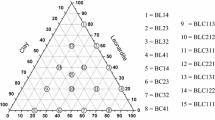Compositions of one-time firing ceramic tile have been developed and tested, using as fluxes phosphogypsum and wastes (LiCl) from the production of acetate fiber. The methods of mathematical planning of experiments were used to obtain a system of mathematical equations that describes the dependence of the ceramic tile properties on the content of different components. The computational results are checked.
Similar content being viewed by others
References
A. P. Zubekhin, L. D. Popova, and A. A. Galenko, “Development of a ceramic mix composition for one-time firing with carbonate flux,” in: Student Scientific Spring – 2008: Proceedings of an Inter-Regional Scientific and Technical Conference of Students, Graduate Students, Young Scientists from the Southern Federal District, LIK, Novocherkassk (2008), pp. 335 – 336.
O. V. Likhota, Technology and Properties of Volume-Colored Decorative Building Ceramic Based on Iron-Containing Clays and Technogenic Materials, Author’s Abstract of Candidate’s Thesis [in Russian], Novocherkassk (2003).
Author information
Authors and Affiliations
Corresponding author
Additional information
Translated from Steklo i Keramika, No. 7, pp. 17 – 19, July, 2009.
Rights and permissions
About this article
Cite this article
Zubekhin, A.P., Galenko, A.A. & Popova, L.D. One-time firing ceramic mix using manufacturing waste products as fluxes. Glass Ceram 66, 249 (2009). https://doi.org/10.1007/s10717-009-9175-x
Published:
DOI: https://doi.org/10.1007/s10717-009-9175-x




